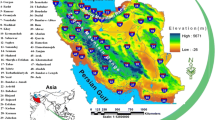Abstract
An iterative chi-square method is applied to determine recent climate change of extremes of daily minimum temperature at two locations between an 18-year recent period and a 36-year prior period. The method determines for each of two locations in northwestern North America, Bozeman, Montana, USA and Coldstream, British Columbia, Canada, which values of the extreme daily weather elements are most significantly different between the prior years and the recent years and gives a measure of the weekly significance of that difference. Determination was made of the average percent of each recent year date (plotted weekly) that was impacted by extreme weather due to climate change as well as the percentage change in the frequency of the number of extreme days for each period of contiguous significant weeks. During the recent period at both locations, most weeks experienced a greater number of days of extreme high minimum temperature and a fewer number of days of extreme low minimum temperature. The weekly percentage changes indicate that extreme high minimum temperatures at both Bozeman and Coldstream are increasing at the rate of about 10% per decade, with a close corresponding decrease of extreme low minimum temperatures. The major changes in climate were very similar at both locations, with greatest warming occurring during the late winter and early spring and during the late July to August period.
Similar content being viewed by others
References
Caprio JM (1966) A statistical procedure for determining the association between weather and non-measurement biological data. Agric Meteorol 3:55–72
Caprio JM, Williams JS (1973) Impacts of induced rainfall on the Great Plains of Montana. Research Report 48, Montana Agricultural Experiment Station. Final Report, Bureau of Reclamation Contract No. 14-06-D7171
Caprio JM, Snyder RD (1984) Study to improve winterkill parameters for a winter wheat model: Task 2, A statistical analysis of weather and winter wheat reseeding relations for application in wheat modeling. Final Report, NASA Contract NAS9-16007
Caprio JM, Quamme HA (1999) Weather conditions associated with apple production in the Okanagan Valley of British Columbia. Can J Plant Sci 79:129–137
Caprio JM, Quamme HA (2002) Weather conditions associated with grape production in the Okanagan Valley of British Columbia and potential impact of climate change. Can J Plant Sci 82:755–763
Caprio JM, Quamme HA (2006) Influence of weather on apricot, peach and sweet cherry production in the Okanagan Valley of British Columbia. Can J Plant Sci 86:259–267
Caprio JM, Fritts HC, Holmes RL, Meko DM, Hemming D (2003) A chi-square test for the association and timing of tree ring-daily weather relationships: a new technique for dendroclimatology. Tree-Ring Research 59:47–61
Cayan DR, Kammerdiener SA, Dettinger MD, Caprio JM, Peterson DH (2001) Changes in the onset of spring in the Western United States. Bull Am Meteorol Soc 82:399–415
De Gaetano A (1996) Recent trends in maximum and minimum temperature threshold exceedences in the northeastern United States. J Climate 9:1646–1657
Dettinger MD, Cayan DR (1995) Large-scale atmospheric forcing of recent trends toward early snowmelt runoff in California. J Climate 8:606–623
Kalma JD, Laughlin GP, Caprio JM, Hammer PF (1992) Chapter 8, Weather and winterkill of wheat: a case study. In: Advances in bioclimatology—2. the bioclimatology of frost: its occurrence, impact and protection. Springer, New York, pp 73–82
Karl TR, Groisman PY, Knight RW, Heim RR (1993) Recent variations of snow cover and snowfall in North America and their relations to precipitation and temperature variations. J Climate 6:1327–1344
Lettenmaier DP, Wood EF, Wallis JR (1994) Hydroclimatological trends in the continental United States, 1948–88. J Climate 7:586–607
Snedecor GW (1946) Statistical methods. Iowa State University Press, Ames
Vincent LA, Zhang X, Hogg WD (1999) Maximum and minimum temperature trends in Canada for 1895–1995 and 1945–1995. Preprints, 10th Symp. on Global Change Studies, Dallas, TX, Amer Meteor Soc, 95–98
Author information
Authors and Affiliations
Corresponding author
Rights and permissions
About this article
Cite this article
Caprio, J.M., Quamme, H.A. & Redmond, K.T. A statistical procedure to determine recent climate change of extreme daily meteorological data as applied at two locations in Northwestern North America. Climatic Change 92, 65–81 (2009). https://doi.org/10.1007/s10584-008-9474-1
Received:
Accepted:
Published:
Issue Date:
DOI: https://doi.org/10.1007/s10584-008-9474-1




